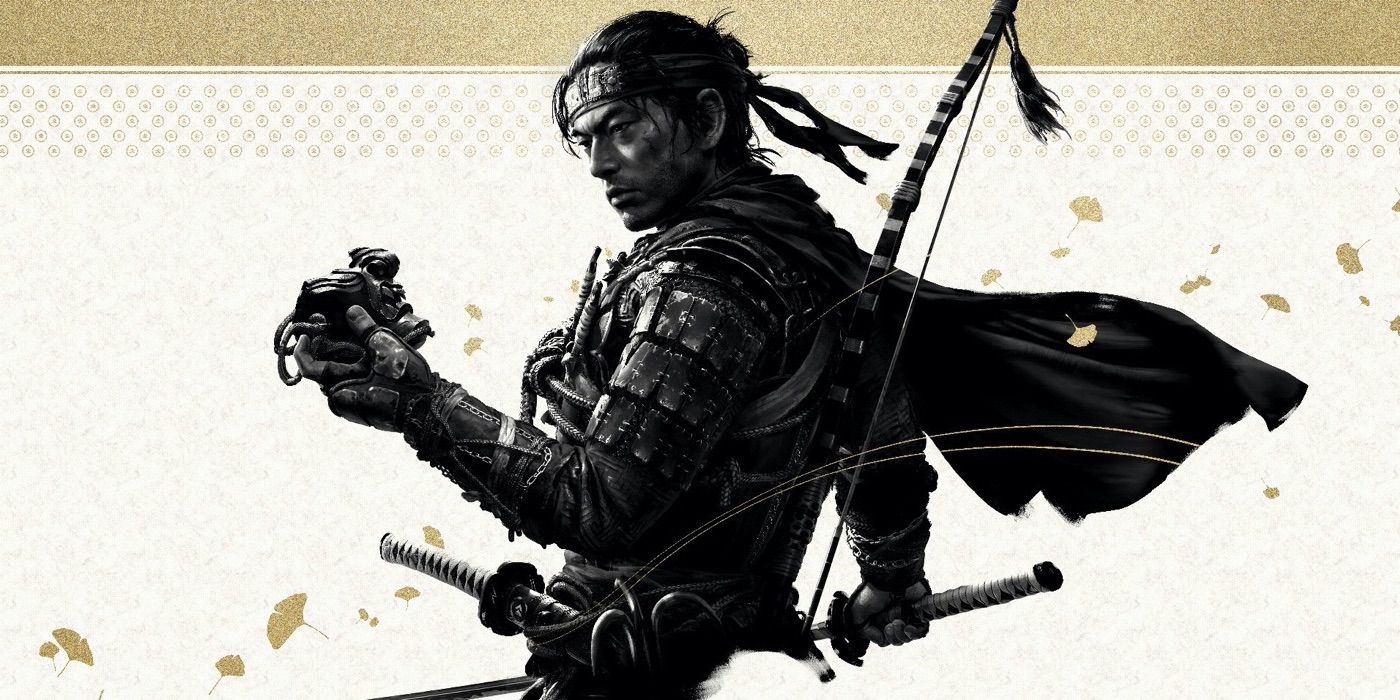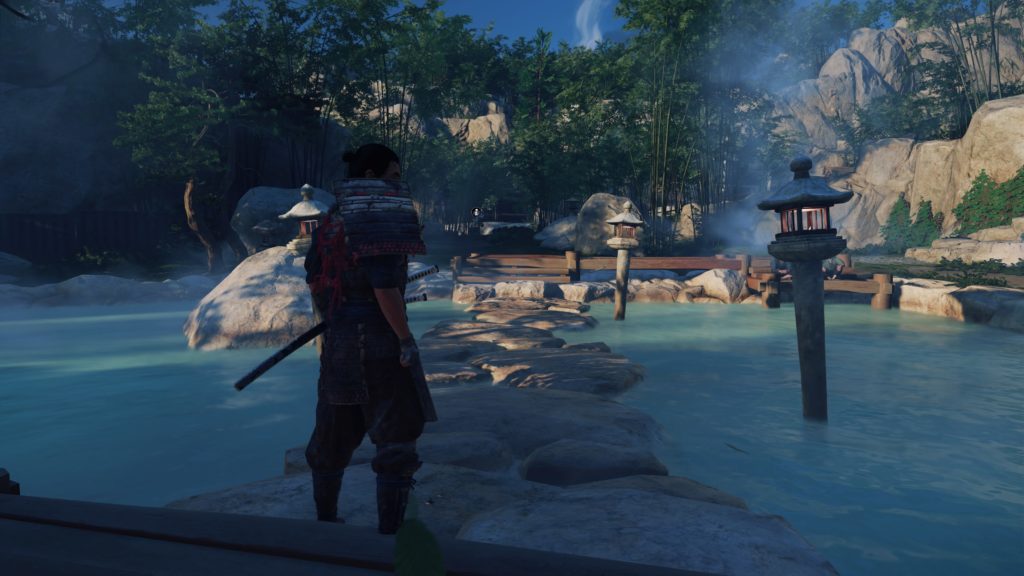Each generation of consoles has speific own games that make it special. These are the games that you recall years later as the highlights of each generation. That particular list of highlights is very long for the PS4 era. And Ghost of Tsushima is the final entry. Released just a few months before the transition to the new generation, Ghost of Tsushima was essentially a next-generation title, held back by last-gen hardware. In July 2020, Sucker Punch managed to win over both critical and public acclaim. A year or so later, Ghost of Tsushima DIRECTOR’S CUT on the PS5 feels exactly like what Sucker Punch envisioned, no longer bound by hardware restrictions.
DIRECTOR’S CUT comes with all the Ghost of Tsushima DLC, as well as next-gen improvements. The base game may have already received the next-gen treatment, running at a higher resolution on the PS5, but 3D Audio and all the features that DualSense brings are now fully supported. The LEGENDS multiplayer mode is included in the DIRECTOR’S CUT version, while the most important addition is Iki Island, a brand new story mode expansion.
Ghost of Tsushima DIRECTOR’S CUT is available for the PlayStation 5, as well as for the PlayStation 4, both as a stand-alone version of the game, and as an upgrade for those who already own the original version.
What’s new in Ghost of Tsushima DIRECTOR’S CUT
The Iki Island Expansion
The biggest thing that DIRECTOR’S CUT brings to the table is the new story mode DLC. This is a new location on the map, Iki is inhabited by all kinds of thieves and swindlers. Iki Island becomes available to explore shortly after the end of Act I in the main story.
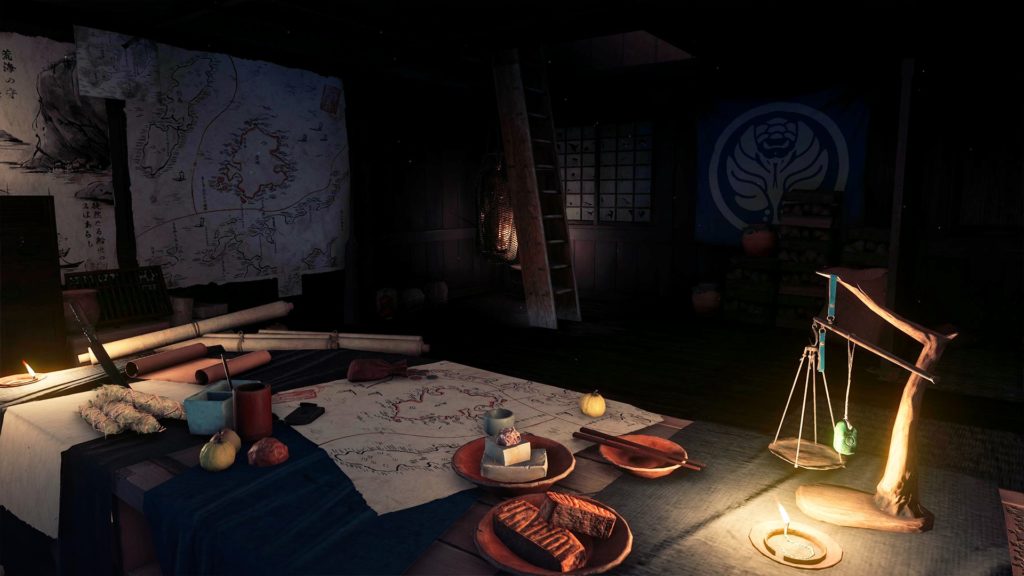
In the middle of his journey, Jin is informed by locals that a band of invading Mongols managed to drive an entire village into madness. Upon investigation, the protagonist discovers that the villagers really seem to be trapped in some strange nightmare. After locating a Chinese altar on the outskirts of the village, he is attacked by a band of Mongols, different from those he has encountered so far. Hailing from Iki Island, and led by the Eagle, these enemies try to subdue the fighting spirit of the Japanese, using supernatural techniques to suppress their fighting spirit. Jin, wanting to put an end to these inhumane tactics, decides to travel to Iki and defeat evil at its root.
Sailing away from Tsushima
We set off, taking the ‘ferry’ to Iki, from where we will not be able to leave unless we complete certain story missions. The island feels just like the rest of Tsushima: full of natural beauty. From peaceful beaches to mysterious forests, it’s awe-inspiring. This game is practically the ultimate eyegasm, and this new expansion is no different. Each screenshot could very well be your next wallpaper. Unlike mainland Tsushima however, Iki has more of a tropical vibe. At the same time, the new questline deals with supernatural themes, something that was briefly touched on in the main game.
Gameplay-wise, the new expansion doesn’t add too much; just a new type of enemy and their pet eagles. The Shamans are essentially Mongolian Priests. Put simply, they stay back and make their front-line warriors stronger through chanting. As long as the Shamans keep hyping the rest of the Mongol warriors, most of their attacks will be unparriable, not to mention 1-hit you. So, you have deal with them first.
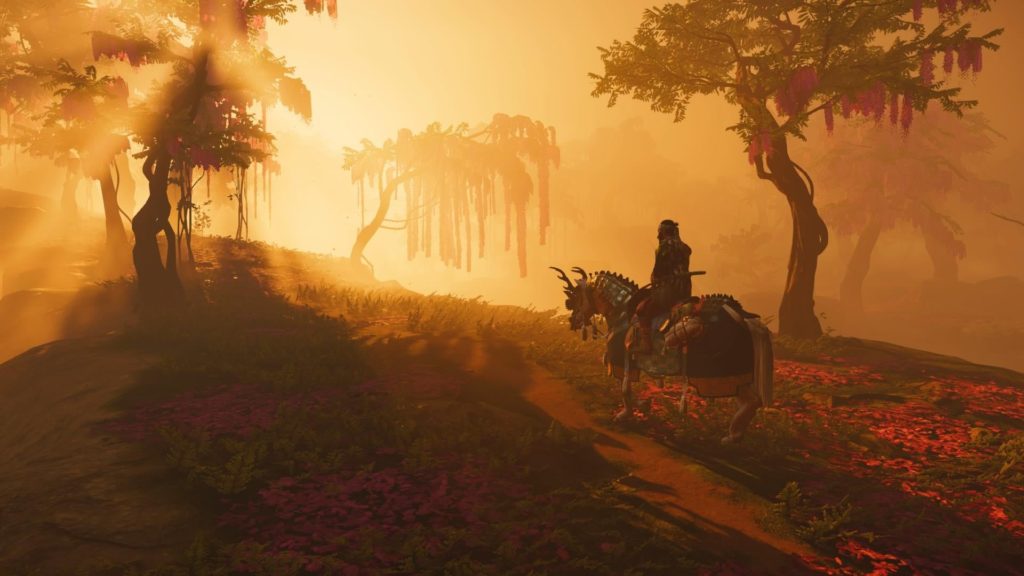
The new DLC is inextricably linked to the main game – it starts like any other side quest. It follows the design language of the rest of the game, aside from the supernatural themes. In essence, it feels just like more of Ghost of Tsushima. You feel like you are playing just “another quest”. For some, it may feel like more of the same, and truth be told, that’s exactly what it is. But is this really a bad thing? If you’re one of those people who wanted “more of Ghost of Tsushima”, this expansion is exactly what you’ve been asking for.
All the next-gen goodness is here
Along with DIRECTOR’S CUT comes the full remaster of Ghost of Tsushima for the PlayStation 5. Even though the game has been running at higher resolutions on the PS5 since February, there is now better reflections and different fidelity modes (more on that below).
The next-gen version now supports the PlayStation 5 3D audio engine, making 13th-century Japan more believable than ever, with the soundscape feeling as immersive as possible. Keep in mind, to take advantage of PS5’s 3D Audio you’ll need a good stereo headset (wink, wink).
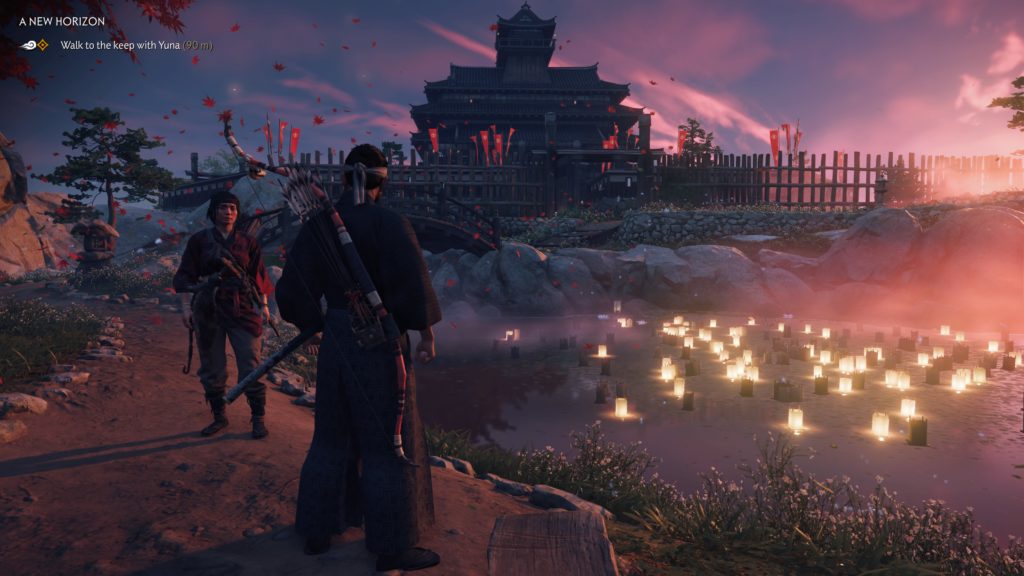
What will go unnoticed – unfortunately – is the full support of all the DualSense suite of features. I’ve seen a lot of people complaining since PS5 launched, that there are only a handful of games that use Sony’s new controller. This, my friends, is the game for you. Unsheathing your katana, you can feel the blade vibrate from one end of the controller to the other, even during cut-scenes. Each time you clash swords, DualSense vibrates intensely. You may not have the sword in your hands, but this is the closest you can get. On horseback, the controller vibrates to the rhythm of the galloping, while when the wind blows, it vibrates gently, as if Jin is shivering from the breeze.
Ghost of Tsushima Review
Visual presentation
A blast from the past
Even on PlayStation 4, Ghost of Tsushima was one of the most impressive games in terms of graphics. This is also true for the PlayStation 5. An intense cinematic feel pervades this game, although it sometimes goes out of its way to accomplish this. Full immersion is the objective here, and that is obvious. The UI is extremely minimalistic, while there is an option to get rid of it completely. The animations are very detailed, with DIRECTOR’S CUT adding full lip-sync to Japanese dialogues. The Kurosawa filter (aptly named after the legendary Samurai film director) that you can activate from the settings, puts a monochrome cinematic filter on top of the game and makes you feel like you’ve just entered a movie theater with your popcorn in hand.

As usual, there are two graphics modes on the PS5: Performance and Fidelity. The first one locks the game at 60fps and plays using dynamic resolution, while the second one runs in native 4K, as close to 60fps as possible. While Ray-Tracing isn’t exactly supported, the reflections and shadows are still very detailed. The scenery in this game looks like it’s straight out of a more exciting version of reality, with shadows and real-time lighting.
What goes unnoticed
In reality, it is the direction of the set pieces that is responsible for Ghost of Tsushima’s intense cinematography. Tsushima Island translates well on the PS5 lens. But beyond that, the whole game is largely allegorically directed. In most shots, Jin Sakai is just a tiny samurai in front of the majesty of Tsushima’s natural beauty. This reinforces the grand narrative which always has you fighting something that’s bigger than yourself. The cut-scenes have a disturbing intensity that clashes with the calm of Japanese nature. Following the same principle, intense Samurai swordfights clash with the always peaceful background.
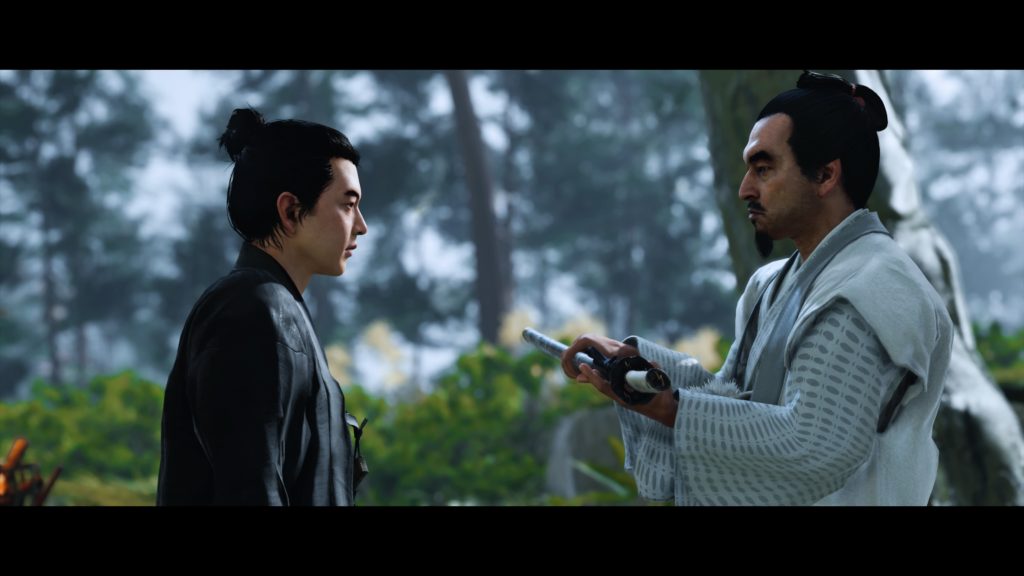
The Tsushima Island
Heavily detailed open-world games isn’t something we haven’t seen before. Most games that draw inspiration from real-life locations, usually use large cities, that tend to be easier to recreate. Ghost of Tsushima, on the other hand, draws inspiration from the natural beauty of the Japanese land.
While Tsushima does actually exist, it’s not exactly as depicted in-game. The world within the game contains tidbits from every inch of Japanese beauty. You’re surroundings constantly change, to keep the player interested. It’s condensed natural beauty, and it’s absolutely fascinating.
Ghost of Tsushima is the cheapest flight you can book to Japan. 13th century Japan, no less. Your eyes will thank you for playing this game. From snowy mountain peaks to peaceful beaches and from traditional temples to blood-stained forts, it’s all here. I may not have taken a vacation this year, but my friend Jin sure did. You can fast travel, but you probably won’t ever feel the need to.
Next level drip
It’s not only the game world and animations that are on-point but so is the overall graphical presentation. In-game costumes and weapons may not be 100% historically accurate, but they certainly manage to build a cohesive world. The menus and the UI are dominated by black and white, with red accents, while the illustrations that adorn the tutorial windows and the gear menus make you feel like you’re reading a story book.
The game completely shifts its vibe during the quests that have to do with supernatural themes, or when in LEGENDS mode. Red dominates the screen, creating a spooky vibe that is quite fitting.
Cosmetics follow the same principles. You style Jin’s outfit however you feel like: from the traditional Samurai armor, to the dreamy Ronin outfit or wanderer’s robes. Everything is upgradeable, while you can also mix and match colors. Swords and bows are also customizable.
Plot
Last Samurai standing
The story takes place in the late 13th century, during the Mongols’ attempt to occupy Japan. We follow the events in the armor of Jin Sakai, an aristocratic warrior, commonly known as a samurai. When the Mongols arrive on the island of Tsushima, the Samurai, as the protectors of the land, confront Khotun Khan’s army, with most of them leaving their ultimate breath in the middle of the battle. Jin manages to survive thanks to the help of Yuna, who will soon prove to be his greatest ally. Without wasting time, Jin sets out to free his uncle, Lord Shimura, who has been captured by the Mongols as head of the Tsushima Samurai.

On his journey, he gathers allies who help him repel the Mongols from Tsushima and restore the Samurai honor. The unorthodox way in which he has to fight the myriads of Chinese soldiers is quite different from the honorable way of Samurai sword fighting. Thus begins the myth of a legendary Samurai who strikes his enemies from the shadows, like a ghost. The legend of Jin Sakai is literally built from scratch. Ghost of Tsushima tells a story of justice, revenge, and rebellion.
Under closer inspection
The plot may seem quite simplistic at first glance and maybe it really is, if you don’t pay much attention. If you are one of those who pay a little more attention to what is going on, there is even more to appreciate here. At the beginning of the story, Jin appears as a mere child, still green behind the ears, with a katana in his hands. A child whose circumstances led him to take up arms and defend his country. After his near-death experience, and realizing that he is, perhaps, the last remaining Samurai, we see him maturing unexpectedly.
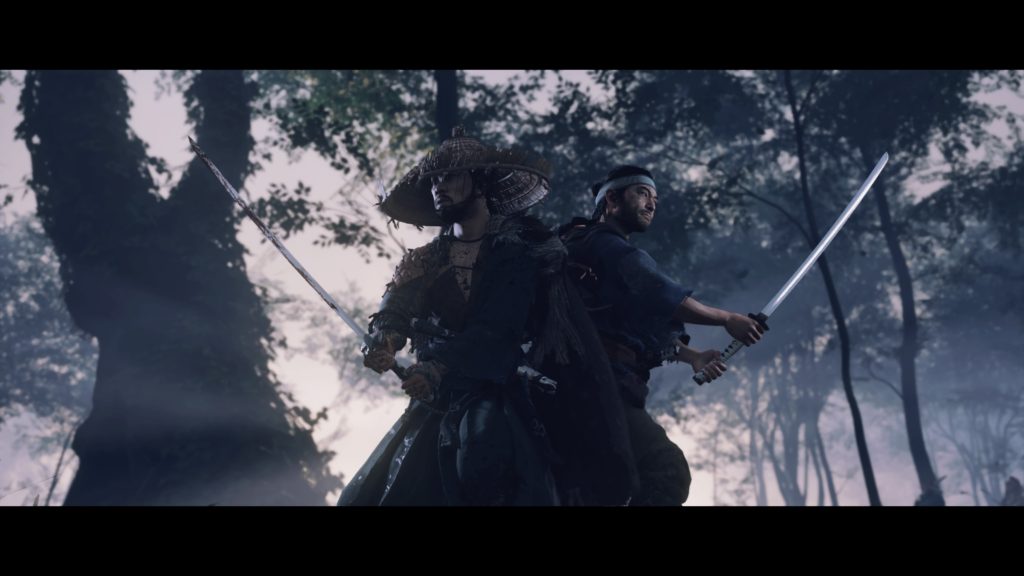
The story is largely linear, but there are some points where the player is required to make minor decisions. These are usually limited to dialogues, where you simply choose the answer you would like Jin to give. These answers reflect the protagonist’s internal disputes about which path to follow: on the one hand are his uncle’s lessons, that is, the Samurai path, and on the other adapting to the circumstances and forging his own path. Two paths largely opposite, set up an internal fight that goes on for the entire duration of the story.

The story flows quite smoothly, all things considered. It’s slow and methodical but at least it keeps a constant speed throughout the game. Essentially, every big plot point is set up by many smaller quests, for a big pay-off. There are some plot twists here and there, but if you pay attention, you can see them coming from miles away. The characters are quite nicely written, which helps a lot since many of the set-up missions in each Act are based on said characters’ backstories.
Gameplay
Fixing the open-world genre
For a few years now, every AAA title has to be open-world… for some reason. While I may not necessarily agree with this trend, when done right, the results speak for themselves. Of course, I can count the games that do it right on one hand. Vast worlds, full of filler content so that they don’t look as empty as they really are: this is the new norm. I’m glad to inform you that Ghost of Tsushima is nothing like that. On the contrary, Tsushima looks quite empty compared to what we are used to. What is missing in filler quests, however, it has in abundance in sights to see.
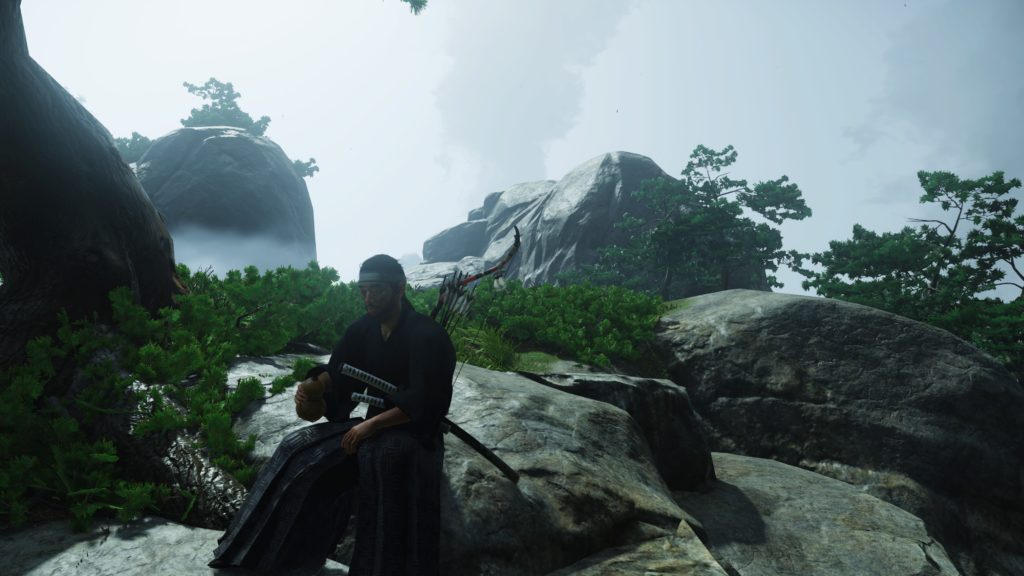
There is a lot of downtime, as you will spend a lot of time traveling from one area to another in this game. But you will always have things to look at as you gallop through the fields of the vast island, the scenery changes quickly in Tsushima. Your jaw will be dropping at regular intervals. Somehow, Jin’s journey becomes your journey. There are much-needed breaks from one mission to the other, the game does not play auto-pilot. Ghost of Tsushima has neither a mini-map nor a compass, even though its world is huge. The wind is what leads you to your next objective. That’s quite the brave design choice and perhaps the coolest thing in the whole game.
Can’t get everything right
But the biggest letdown in Ghost of Tsushima is that it doesn’t take advantage of its huge map in the main questline. Tsushima is huge, and you can get to the end of the main story with your map being largely locked. To explore the island, you must either get lost or try looking for yourself. Side-missions are a bit of a snooze-fest, but there are many things to see and unlock. And those who only play to see what happens in Jin’s story will miss the best sights.
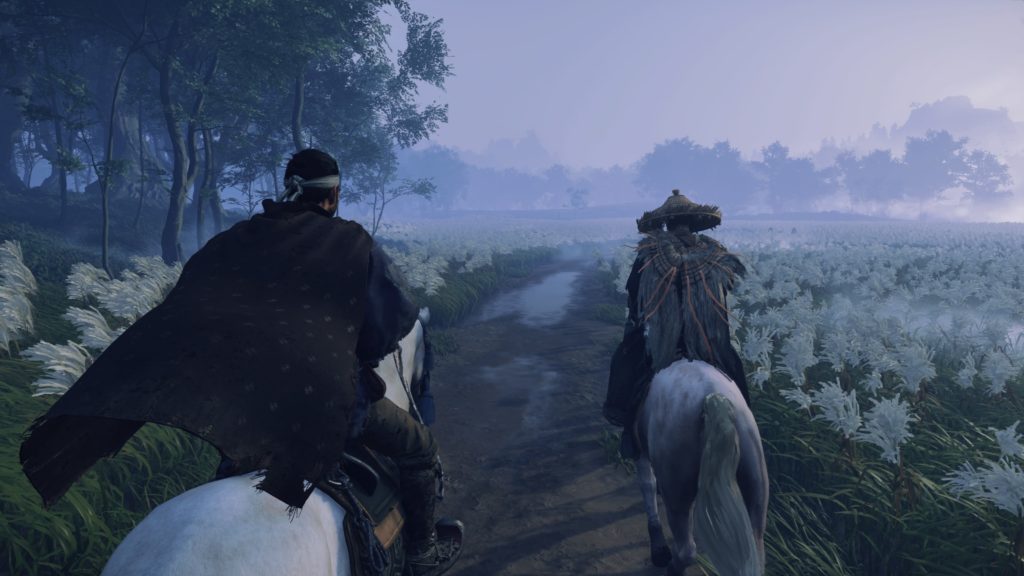
Combat
Could you imagine a game based on the legendary Samurai warriors without a decent combat system? Thankfully, you won’t need to. Ghost of Tsushima’s combat system is excellent. It’s based on simple combos with quick and heavy attacks when starting out, but soon gains depth thanks to the many factors that affect the gameplay. Stances change the way Jin sets up his body, making it easier to deal with particular types of enemies. Stances change on-the-fly so you can adapt to the type of enemy in front of you. The quick-healing system is based on how well you are doing in battle. The better you are at sword fighting, the more forgiving the system will be.
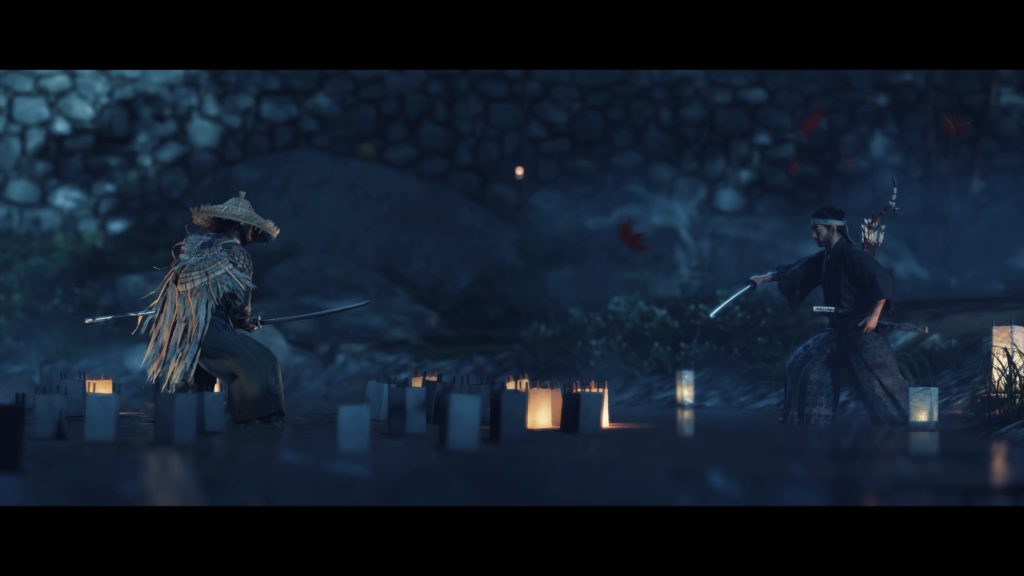
Jin’s arsenal is large and varied. Your katana will of course be your best friend, and the parry will be done instinctively after a while. There are ranged weapons like kunai and of course, your bow, which give another dimension to sword-to-sword battles. At the same time, smoke and sticky bombs will help you face whole armadas of Mongols as soon as you unlock them, something that at least at the beginning of the game, seems impossible.
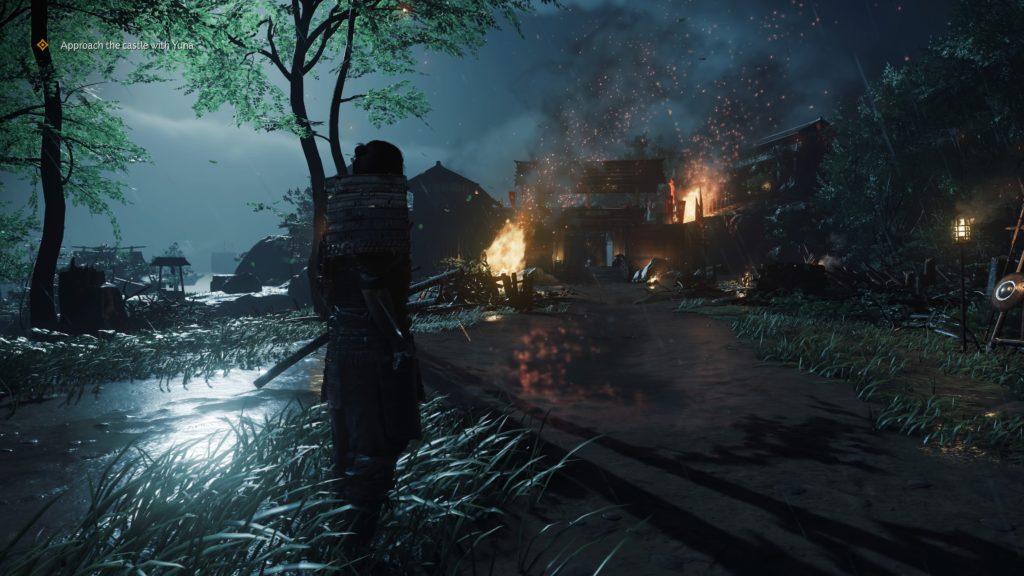
Honestly, the Stances are the most remarkable feature of the battle system. They force you to always be wary of what kind of enemy you’re facing and not just mash the buttons isntinctively. In general, enemies – even in the middle difficulties – punish carelessness, especially on the earlier levels. And the slightest wrong step will make you take enough damage. The battle here is a skillful dance and when you miss a step, you get stepped on. Of course, it’s not perfect: some enemies just teleport close to you in order to hit you, even if you have already dodged their attack. Such bugs (or artificial difficulty – call it as you may) will make you die several times for no reason.
Stealth of Tsushima
Precisely because you can’t lock swords with the entire Mongol army from the beginning of the game, there are stealth sections. You will need to learn to pick your battles. You can easily appear behind unsuspecting enemies and kill them before they even realize what’s happening. It’s not the most honorable way to win battles but, hey, Ezio would be proud.
Role playing with no skill tree? Not on my watch
Of course, Ghost of Tsushima is an RPG. Everything you do in the game, whether these are main story missions or random encounters, will give you XP. With said XP, you unlock Technique Points which you can spend to improve your battle abilities. You can to choose from general abilities, or stance-specific. At the same time, every 4 levels, the legend of Jin will grow (literally), and you have the ability to add a new weapon to your arsenal.
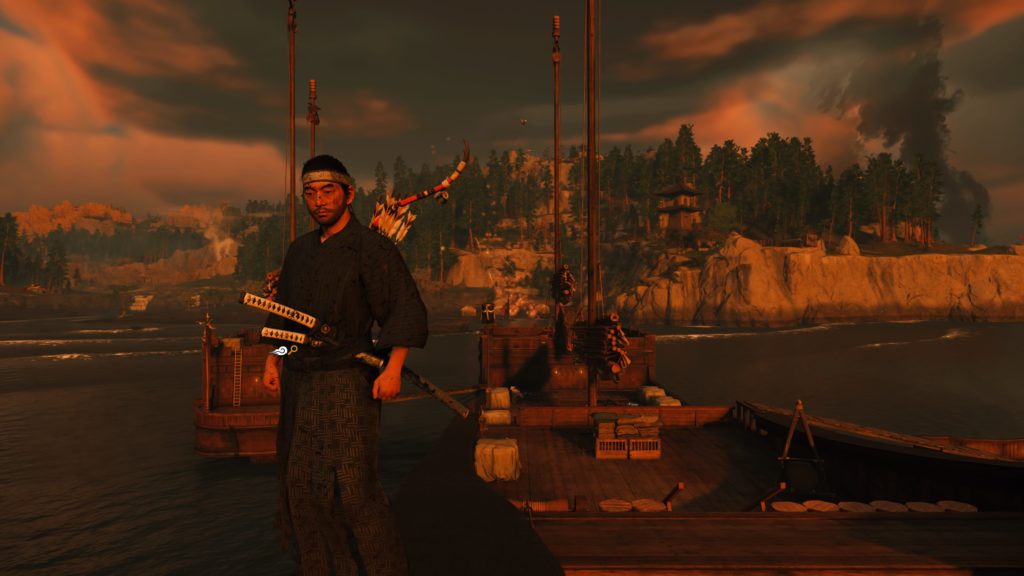
Your weapons and armor are fully upgradeable and you can upgrade them by gathering the required raw materials. However, to upgrade, you must find the corresponding craftsman: swordsmith for your swords, armorer for armor, and so on.
Sound
Sound effects and ambient sound
The visual presentation is the first thing you notice in every game, but no experience is complete without the corresponding level of audio fidelity. Sucker Punch has done a good job in this department as well. The ambient sound is at an excellent level when traveling in the Japanese wilderness. You’ll get used to hearing the sounds of the winds every time you swipe-up on the Touchpad to see where you need to go. The occasional chirping of birds will lead you to the secrets of Tsushima. Foxes will be howling trying to get your attention. Bears will be growling, trying to scare you away. The voices of passers-by on the street. Everything composes a versatile soundscape that is enhanced by the PlayStation 5’s 3D audio engine.
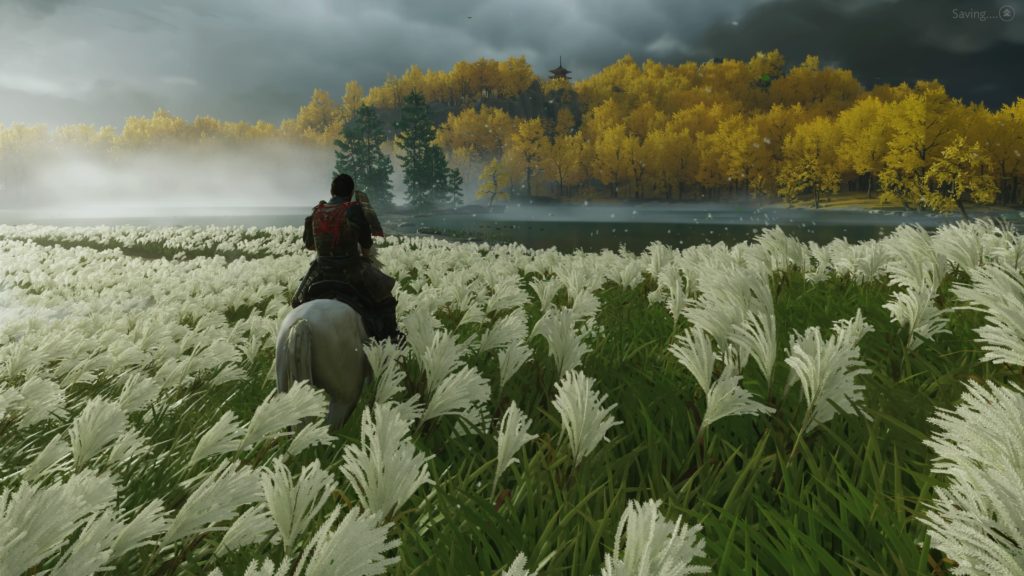
We do suggest you experience Ghost of Tsushima using a good pair of headphones. During battle, the sound of clashing swords will echo loud in your ears. Audio cues play an active role in combat, with archers warning you before they start shooting their volleys. At the same time, you hear the war cries of the opponents outside your field of vision. Explosions are just as much boomy as needed – enough to destabilize you, but this is no Call of Duty.
Music
I don’t know what you’re expecting to read here, but Sony has been spoiling us with exquisite soundtracks for its games for a while now, and Ghost of Tsushima is no exception. The soundtrack includes tracks for every moment of gameplay, ranging from serene tracks when you are on the horse to stormy battle themes. All pieces contain classic Japanese instruments, such as the iconic Samurai flute. Jin can even play his own melodies on the flute, and you can even unlock new ones through collectibles.
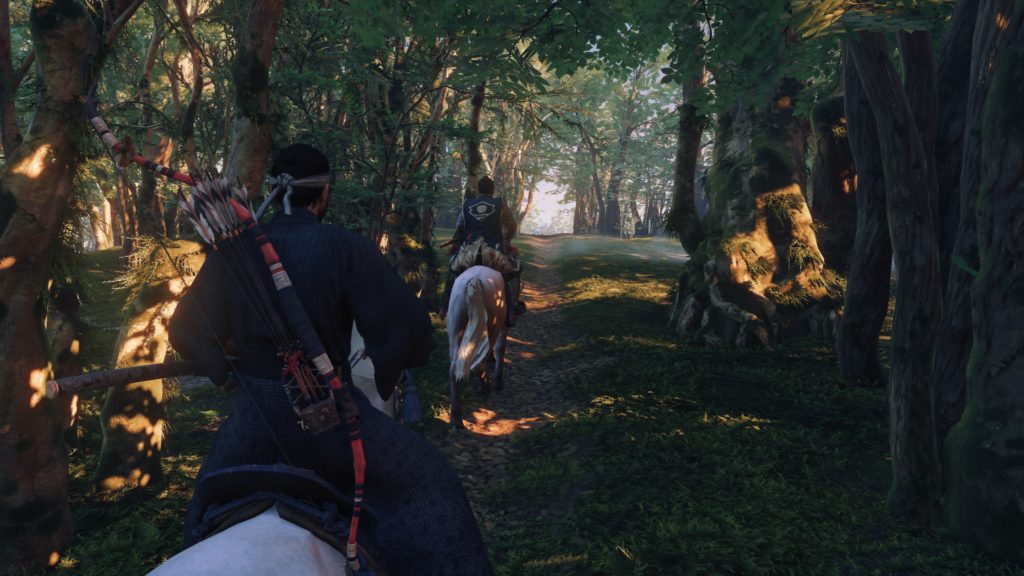
The only setback with the music is that you don’t get to listen to it as often as you should. There are many moments of uncomfortable silence. This is a design choice during gameplay, so that the soundscape is highlighted. During some cut-scenes though, the lack of music – especially when the characters are simply conversing – becomes painfully obvious.
Verdict
If you haven’t played Ghost of Tsushima
Ghost of Tsushima gives you the opportunity to travel to a magical world and get into the armor of a legendary Samurai. The visual composition set up by Sucker Punch is truly awe-inspiring. The screenshots you will see in this review don’t really do justice to the game, as the magic lies in the animation. The combat will be a bit difficult at first, but once you get the hang of it you will quickly become addicted to how easy it is to slash your way through hordes of enemies, just as the Samurai folklore describes. The plot tells a story of revenge, while the burden falls on the characters to give the protagonist important lessons about life and honor, depending on whether they betray him or show devotion. In addition, the LEGENDS mode gives you the opportunity to fight alongside your friends, for a co-op samurai experience.
There’s a few issues here and there, of course. Ghost of Tsushima is not perfect. But it gets close enough. Some problems were not fixed even with the remaster. Still, it remains one of the must-play titles on PlayStation, with next-gen upgrades unlocking what was held back by the last generation hardware.
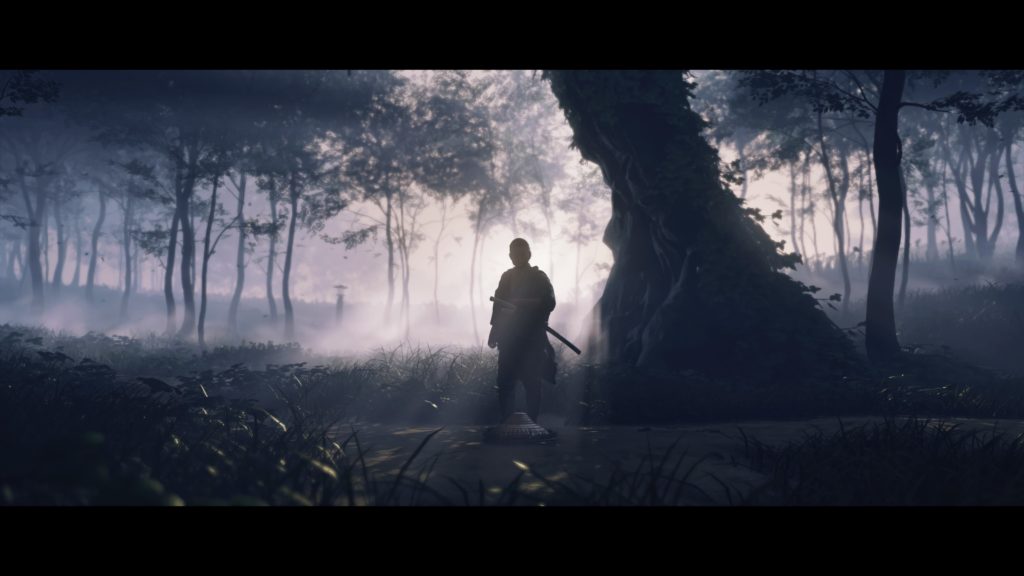
If you have played Ghost of Tsushima
DIRECTOR’S CUT is available as an upgrade for € 20 for original PS4 game owners. Those who upgrade to the PS5 version also have access to all the next-gen upgrades. Ray-Tracing and the capabilities of DualSense won’t leave you any room to think too hard about it, especially if you are looking for an opportunity to dust-off your katana.
PS4 owners, however, only get the new expansion with the upgrade and this was the reason for quarrels among the fans. Of course, even if Iki Island were available as a stand-alone DLC, it would still cost €20, like most DLC expansions. If, after completing the main game, you would like to play more, Iki Island is exactly what you’re looking for. A new storyline lasting about 5-6 hours, a new area to explore, and the same mechanics that kept you hooked to the original game. It’s up to you, Samurai.
Huge thanks to PlayStation Greece for providing the review copy we used for this review.
